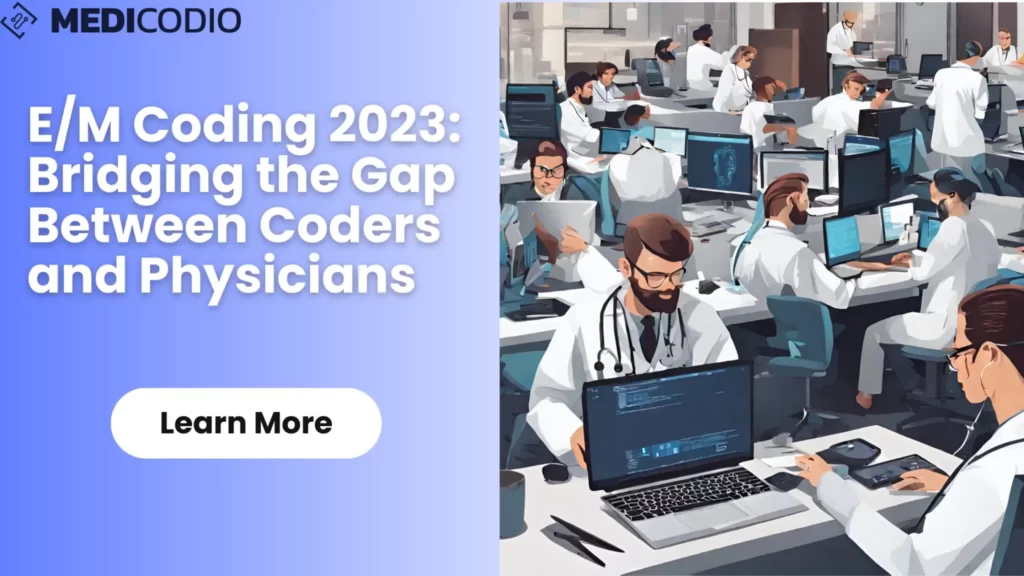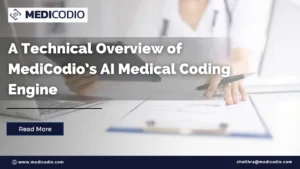In the ever-evolving landscape of healthcare, efficient and accurate Evaluation and Management (E/M) coding is paramount. Ensuring that your coders and physicians are on the same page when it comes to Medical Decision Making (MDM) is not just a matter of compliance; it’s a crucial element in optimizing patient care, reducing claim denials, and ultimately improving your bottom line. In this comprehensive guide, we delve deep into E/M coding, uncovering strategies to bridge the gap between coders and physicians and elevate your healthcare practice to new heights.
What is E/M coding?
E/M coding, short for Evaluation and Management coding, is a system used in healthcare to classify and bill for patient encounters based on the complexity of medical services provided by physicians.
E/M coding is used to report evaluation and management (E/M) services, which are the services that a physician or other healthcare professional provides to assess a patient’s health and develop and manage a treatment plan. E/M services include office visits, hospital visits, home visits, and preventive care services.
FYI: Procedures such as diagnostic tests, radiology, surgeries, and other particular therapies are not considered evaluation and management services.
How is E/M coding different from ICD, HCPCS, and CPT coding?
E/M coding focuses on categorizing patient encounters based on the complexity of medical services.
In contrast:
- ICD coding (International Classification of Diseases) identifies specific diagnoses or health conditions.
- HCPCS coding (Healthcare Common Procedure Coding System) is used for procedures, services, and supplies.
- CPT coding (Current Procedural Terminology) is used to report all other medical services and procedures, including diagnostic tests, surgeries, and radiology procedures.
Another important difference between E/M coding and CPT coding is that E/M coding is based on the complexity of the patient’s condition and the amount of time and effort that the physician or other healthcare professional spends on the visit. CPT coding, on the other hand, is based on the specific service or procedure that is performed.
Here is an example:
- A patient comes to the doctor’s office for a routine checkup. The doctor performs a physical exam, reviews the patient’s medical history, and orders some blood tests. The doctor also spends time talking to the patient about their health and answering their questions.
- This visit would be coded as an E/M service, and the specific code that the doctor uses would depend on the complexity of the patient’s condition and the amount of time and effort that the doctor spent on the visit.
- If the patient’s condition was simple and the doctor only spent a few minutes with the patient, the doctor might use the code 99214. If the patient’s condition was more complex and the doctor spent more time with the patient, the doctor might use the code 99215.
If the patient had needed any additional services or procedures during the visit, such as blood tests or a vaccination, those services would be coded separately using CPT codes.
Understanding the E/M Coding Challenge
The Complex World of E/M Codes
E/M codes, or Evaluation and Management codes, are an integral part of medical billing and coding. These codes determine the level of service provided during a patient encounter, taking into account various factors such as history, examination, and Medical Decision Making (MDM). Accurate coding is essential not only for reimbursement but also for medical record documentation and compliance with regulatory standards.
The Divergent Perspectives
The challenge often lies in the disconnect between coders and physicians. Coders rely heavily on documentation to assign the appropriate E/M codes, while physicians prioritize patient care and sometimes struggle to provide the level of detail coders require. This discord can lead to discrepancies in code assignment, claim denials, and potential legal ramifications.

Filling the Gap
1. Establish Clear Communication Channels
Communication is the foundation of any successful healthcare team. Create open lines of dialogue between your coders and physicians to ensure they understand each other’s needs and constraints. Regular meetings and training sessions can facilitate this process.
2. Educate Your Physicians
Physicians may not be well-versed in the intricacies of coding. Provide comprehensive training on the importance of accurate documentation and its impact on reimbursement and compliance. Encourage them to ask questions and seek clarification when needed.
3. Implement E/M Coding Guidelines
Adopt standardized E/M coding guidelines such as those provided by the American Medical Association (AMA) or the Centers for Medicare & Medicaid Services (CMS). These guidelines can serve as a common reference point for both coders and physicians, reducing ambiguity.
4. Leverage Technology
Invest in Electronic Health Record (EHR) systems that support E/M coding. These systems can streamline documentation, prompt physicians for necessary details, and facilitate code assignment.
The Role of Medical Decision Making (MDM)
Defining MDM
Medical Decision Making (MDM) is a critical component of E/M coding. It involves the evaluation of a patient’s medical condition, the complexity of data reviewed, and the risk of complications or morbidity. Accurate MDM documentation is essential for coding and reimbursement accuracy.
Aligning Coders and Physicians on MDM
To ensure that coders and physicians are on the same page regarding MDM, consider the following strategies:
a. MDM Training
Offer training sessions specifically focused on MDM for both coders and physicians. Provide real-world case studies to illustrate the concept and its practical application.
b. Documentation Templates
Develop standardized documentation templates that prompt physicians to include MDM-relevant information. These templates can be integrated into EHR systems for ease of use.
c. Regular Auditing
Conduct regular audits of E/M coding and documentation to identify areas of improvement. Provide feedback to coders and physicians to foster continuous learning and improvement.
The Benefits of Alignment
Achieving alignment between coders and physicians in the realm of E/M coding offers a multitude of benefits:
Enhanced Reimbursement: Accurate coding results in improved reimbursement rates, minimizing revenue loss due to claim denials.
Compliance: Aligning with coding guidelines ensures compliance with healthcare regulations, reducing the risk of audits and penalties.
Efficiency: Streamlined processes and clear communication lead to greater operational efficiency within your healthcare practice.
Patient Care: By accurately documenting MDM, physicians can make more informed decisions, ultimately benefiting patient care.
Conclusion
E/M coding is a complex but essential aspect of healthcare administration. Bridging the gap between coders and physicians, especially in the realm of Medical Decision Making, is a pivotal step toward success. Clear communication, education, guidelines, and technology integration are the pillars upon which alignment is built.
In your journey to excel in E/M coding, remember that the collaboration between coders and physicians isn’t just a matter of compliance; it’s the key to delivering optimal patient care while optimizing your practice’s financial health.
Experience the power of AI-powered medical coding assistant firsthand with CODIO’s 30-day free trial. Try Now!





